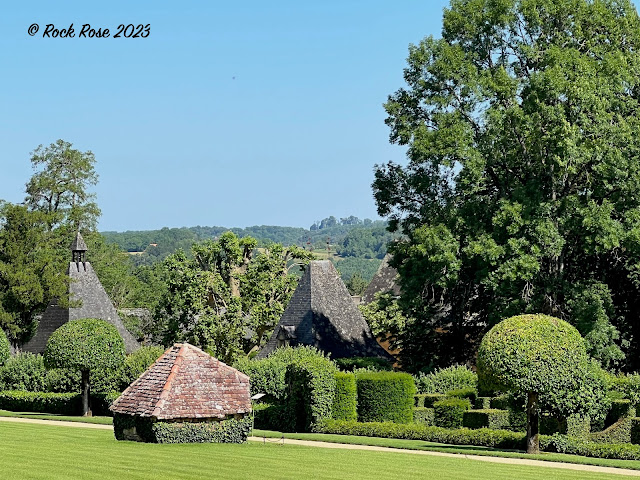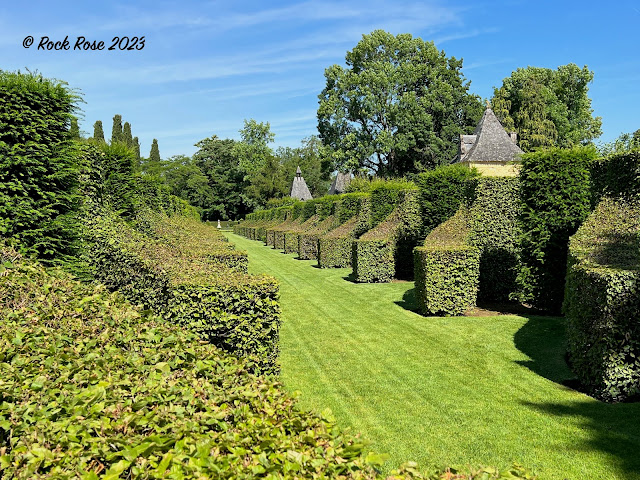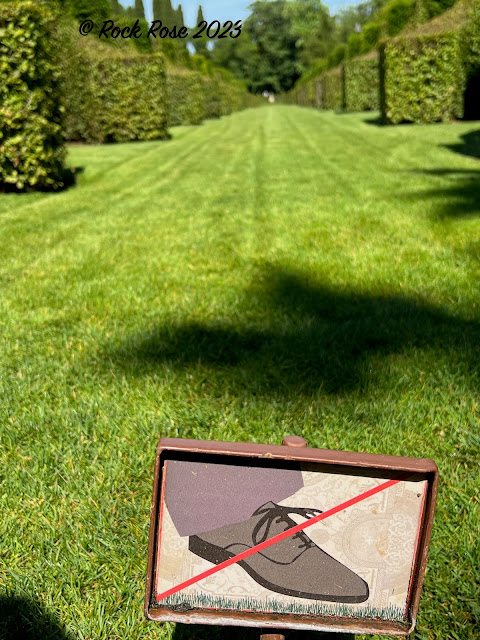This summer we spent a week in the village of Sarlat-la-Canéda, in the Perigord district of France. It was garden friend Helen Battersby who posted on Facebook of her brief visit to the village. Sarlat is a thriving medieval village and while it might be a little touristy it is still charming and close to the caves at Lascaux. A place I had longed to visit. Further research turned up a couple of note-worthy gardens as well as ancient dwellings and lots of interesting French villages. We booked a week in a gîte on the edge of the village, flew to Toulouse, rented a car and drove up to Sarlat.
D'Eyrignac was just a few kilometers from the village and on a perfect June day we entered the gardens.
The garden entry didn't give much away of what we were going to see. Entry was through the shop after which we passed the restaurant with outdoor seating. It had become our habit while France to have the main meal of the day at lunch and this looked like the perfect venue. A flight of steps and a long gravel walkway along the edge of a large beautifully mowed lawn was to lead us down into one of France's most beautiful topiary gardens.
The property has been in the family for 500 years. Twenty two generations have made this their home. The original manor house was built in 1653 on medieval foundations and changes to the garden have been frequent. By the 1960s the stone terraces and walls had become buried by years of neglect. In 1964 the current owner, Gilles Sermandiras, told his family he was going to use all the funds available to him to create a garden, not in the historic sense but a new creation. The family protested, but his mind was made up. He had no formal training and when interviewed in his 90s he said it was 'made with my soul and character"
He used hornbeam, yew and boxwood to create gardens which are reminiscent of the work of La Nôtre. A team of 12 people including 6 gardeners care for the topiary using only hand made tools. Most of the trimming is done between June and September. A total of 20,000 hours of work a year. The hornbeam allee has 3 Michelin stars in their Green Book.
Rising above the hedge you see stone buildings built in the French Style with steep slate roofs. They entice you beyond the Allee des Charmes. You might be tempted to walk between the rows of clipped hornbeam but a sign reminds you not to do so.
This walkway of star jasmine on Neo Gothic arches is the only unclipped hedge in the park and a reminder of the English garden style which found its way into many French gardens in the 19th C.
At the end a garden statue of "The God of Passing Time" found when excavating the garden.
Simple in design but glowing in the clear morning light the manor house with an espalier of a white roses either side of the door.
In front a wide gravel courtyard looking onto a small pond and two flights of stone steps leading up to the French parterre gardens. Visitors may walk up the steps but not venture into the gardens. The gardens were meant to be viewed from the second floor of the house but entry into the house is not possible for the visitor.
 |
The gravel steps planted with fleabane daisy. Possibly E. karvinskianus, Mexican fleabane.
 |
Or from the side of the French Parterre. No entry permitted.
Returning to the courtyard and climbing the steps to the pavilion on the right we found ourselves in a small chapel dating back to Louis X1V. The rooms above were once used to grow the silk worm caterpillar and the silk sent to the silk makers in Lyon.
There were a few tables and chairs in the courtyard and we sat for a while in the shade just enjoying the peace, before walking on to explore the rest of the garden. It was almost as though we had the garden to ourselves. We ventured through the archway through which carriages must have ridden delivering friends and family to the front door. Maybe this building was the gate keepers house.
And past the working barns that once housed horses we found the Washing Place. The property is fed by seven springs and one of those springs used to feed the stone washing place which could accommodate 6 washerwomen. Twice a year the family would get together with neighbors to do the washing.
The gardens become less formal with a large vegetable garden and a cutting garden.
Topiary waiting for their turn in the garden.
It would seem that the owners now fly in and land on their own private runway.
After walking along the back of the property through the wildflower meadow and orchard we climbed back up to the most recent addition to the property, the White Garden representing purity and elegance.
Two roses opalia and Madame Alfred Carrière were chosen for their repeat bloom from spring until frost. In other beds gaura and petunias take over from the spring bulbs, hyacinth, tulip and narcissus. If you are visiting in the summer, on a Friday, they open the gardens for picnics. You can either order one or bring your own but you must be dressed all in white!
Fountains and topiary mixed with roses and summer flowers give a less formal feel to the gardens and visitors are welcome to walk around on the paths. The view from the top is of the Dordogne landscape. And suddenly we found ourselves on the far side of the lawn. It was time to find our table on the terrasse for an early lunch. And what else but confit of duck. We are after all in the duck capital of France.
Bon Appetit!







.jpeg)












.jpeg)
.jpeg)

































5 comments:
Their own landing strip would have put it over the top for me, if the topiaries hadn't already done that. That's a different world to be sure. I had to laugh at the local washing place used twice a year.
It is just about impossible to imagine the same family in residence for so many years. I wonder what it must feel like to marry and have to move away. I would find it hard to leave such a glorious house and garden. Maybe the eldest child gets to move into the gatehouse.
Well, that was an interesting and delightful tour. That many generations of one family here? I can't even imagine it. Thanks for sharing your visit, Jenny.
What a wonderful trip, and the food looks delicious! Thanks for sharing some of the highlights!
beautiful blog..
thanks alot for sharing..
github.com/reph
Post a Comment